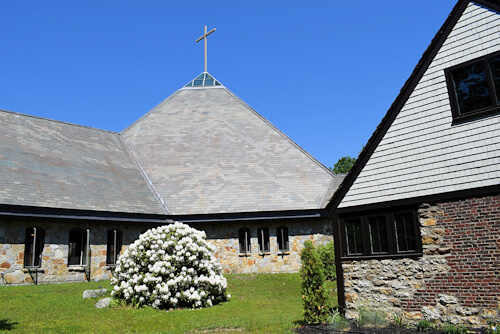Praying the Liturgy
In the darkness, a single voice breaks the silence of the night, intoning “Domine, labia mea aperies” (“Lord, open my lips”). And the rest of the monks respond “Et os meum annuntiabit laudem tuam” (“And my mouth will proclaim your praise”) (Psalm 51:15). So Vigils, also known as the Office of Readings, begins at 5:00 am in our monastic church, and so the liturgical day begins at St. Mary's. As a contemplative Benedictine monastery, St. Mary's has the liturgy, the sung praise of God— Father, Son, and Holy Spirit— at the center of its life, and the day’s schedule is structured around the times for the Divine Office, or, as it is otherwise known, the Liturgy of the Hours.
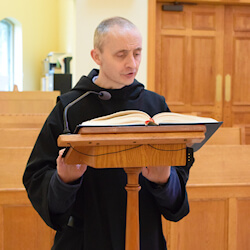
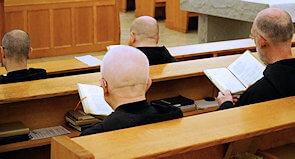
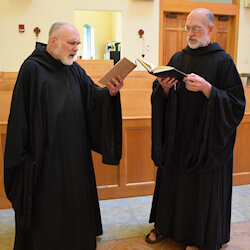
The Divine Office
The Divine Office, by calling the monastic community together for praise of God seven times a day (Psalm 119:164), consecrates the whole of the day to God and sanctifies the various hours of the day. With Lauds and Vespers being the principal Offices, it is especially then morning and evening, sunrise and sunset, the coming of light and its departure, which are consecrated in the liturgy. By this cycle of prayer, the monk is called to remember and praise throughout the day the Lord who created the day. The essential elements in an Hour of the Divine Office are: hymn, psalms, a Scripture reading, and a prayer of petition. Its structure, or rhythm, then, is that of a dialogue with God, as we listen to God’s word and respond to him. Our participating in the liturgy with voice and ear inserts us into this conversation with God, and this rhythm of the liturgy is meant to shape our hearts as well as our day. Both in our exterior daily schedule and in the interior formation of our hearts, we strive to follow what St. Benedict says in chapter 43 of his Rule, that “nothing is to be preferred to the Work of God”. That our prayer and all our actions during the day are centered on and formed by the Divine Office and the Eucharist is our way of witnessing to the declaration of the Second Vatican Council’s Constitution on the Sacred Liturgy (n. 10): “The liturgy is the summit towards which the activity of the Church is directed, and, simultaneously, the source from which all its power flows out”.
Gregorian Chant
At St. Mary's we sing the Mass and the Divine Office in Latin Gregorian Chant together with the nuns of St. Scholastica Priory. Traditionally associated with St. Gregory the Great, who was a monk prior to being elected Pope in the year 590, and who was the great transmitter of monastic culture to the succeeding centuries, Gregorian Chant was the principal music of most of the Latin church beginning in the early Middle Ages. Contrary to a widespread misconception, the preservation and use in the liturgy of the Latin language and Gregorian Chant was encouraged both by Vatican II, Pope Paul VI (especially for monasteries), and more recently by Pope Benedict XVI and the Synod of Bishops in Sacramentum Caritatis (n. 62). Gregorian Chant and Latin are used by a number of monasteries throughout the world, including our motherhouse, Pluscarden Abbey.
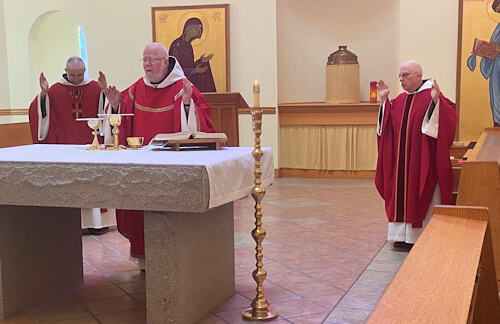
Celebration of the Eucharist
Our celebration of Mass is always according to the Novus Ordo, that is, the Missal of the Second Vatican Council—not the Tridentine. Only on Thursdays do we have Mass prayers completely in Latin. On other days the prayers are in English while the chants alone are in Latin, i.e., the entrance hymn, the Kyrie (Greek), the Gradual (which for us replaces the Responsorial Psalm) and/or the Alleluia, the Offertory hymn, the Sanctus (Holy Holy Holy), the Agnus Dei (Lamb of God), and the Mystery of Faith. On Sundays and Solemnities, the Gloria (Glory to God) and the Credo (I believe) are also chanted. All these chants are taken from the approved books produced since Vatican II by the Abbey of Solesmes in France, the main proponent of Gregorian Chant both before and after the Council. Most date to the tenth to fifteenth centuries, while some hymns of the Office date back to as early as the fourth.
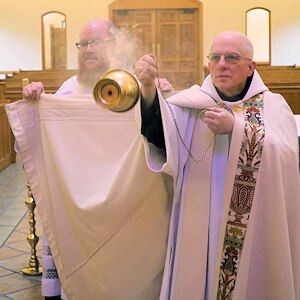
The Communion of Saints
St. Paul tells us that “our homeland is in heaven, from which we await a Savior, the Lord Jesus Christ” (Phillipians 3:20) and that “we are fellow citizens with the saints” (Ephesians 2:19). Vatican II reminds us that “in the earthly liturgy we take part in a foretaste of that heavenly liturgy which is celebrated in the Holy City of Jerusalem toward which we journey as pilgrims, where Christ is seated at the right hand of God” (Sacrosanctum concilium n. 8). We invite visitors and guests and those interested in the monastic life to join Christ, the angels, the saints, and us earthly monks and nuns in singing this divine song of praise which the Son of God, by taking on our human nature, introduced here on earth.
